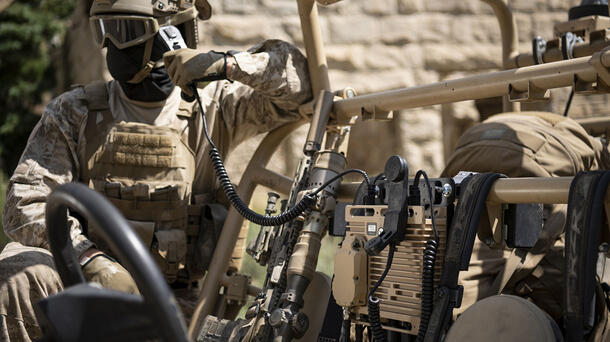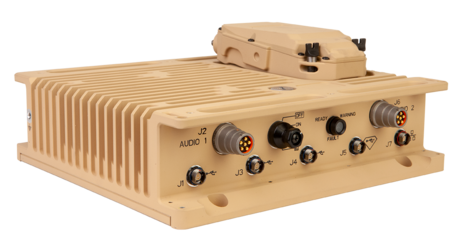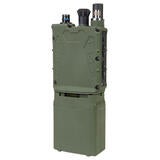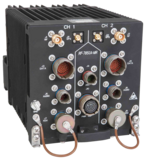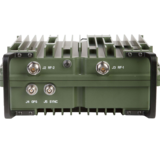The ability to prepare for future critical customer mission needs is the driving force in L3Harris Technologies’ design approach for its Falcon® III RF-7850 line of radios.
The company’s focus on flexibility and low-Size, Weight and Power (low-SWAP) designs – as well as designing for manufacturability – allows L3Harris and its customers to stay ahead of both emerging threats and new network requirements, according to Kevin Steubing, L3Harris vice president of International Business Development. Further, the software-defined approach to the radio family’s design provides a myriad of options and customization to fit the unique needs of individual mission sets and users.
This is why, in just 13 years, L3Harris has shipped more than 100,000 radios to nearly 100 customers across six continents.
“The platform offers vehicular, dismount and airborne form factors, and the commonality between the different-sized products throughout the family is a big part of its success,” Steubing said. “Customers want RF-7850 radios because they work with other products they have in their inventories. It’s all interoperable.”
A Decade of Innovation

The genesis of the L3Harris RF-7850 family of radios – and the Falcon® III product line as a whole – was the RF-7800V, according to Brad Hall, L3Harris Product Analyst lead. Recognizing the vital need to penetrate contested or congested environments with resilient multi-domain information, the company rolled out new products every few years to meet the demanding need. This included the RF-7850M – providing the power of a manpack in a handheld device – in 2013, and airborne and secure personal radio variants in 2015.
In 2021, the company released the RF-7850D, the first dual-channel wideband vehicular radio, and a mission module for the same radio in 2023, which provides an additional channel for the device.
The common interfaces and useability of the devices were the keys to success for the radio line, according to Hall. Swapping between devices within the line is analogous to using the same commercial brand’s smart phone then tablet, he said.
“Since we design the radios for manufacturability, our customers can establish manufacturing centers in their own countries, which supports L3Harris’ Transfer of Technology and product localization strategies,” Hall said. “Several customers have their entire RF-7850 procurements built in-country, which has significantly helped production rates over the last few years.”
Recent global conflicts have also led to a need for mass production of international radios.
“Resilient communications has always been a focus for the RF-7850 product family, but, in the last two or three years, there has also been an increased recognition of the need for coalition and interoperable devices," Tim Steltzer, L3Harris Product Management lead, said. "The radio family is well positioned to meet those requirements as well.”
Industry-leading Waveform Development
L3Harris understands that radio communications are only as good as the security they provide. Each year, the company makes heavy investments to ensure its customers have the resiliency, encryption and coalition interoperability to complete missions efficiently and effectively regardless of new adversarial threats.
The RF-7850 line received access to the innovative, resilient QuickLook3 waveform in 2012 and access to the resilient TNW-75 networking waveform in 2017. The company continues to enhance both waveforms.
“The business invested in resilience early, before the larger international audience realized how important it was, and that’s why we have been positioned so well to meet the mission requirements of the current global conflict zones,” Hall said.
The RF-7850 family of radios taps into L3Harris’ robust library of resilient waveforms to deliver multi-domain coalition interoperability for voice communications and secure data networking across contested environments. This includes the new Anti-jam Resilient Radio Objective Waveform (ARROW™) – available on the A, D, M and V variants – delivering resilient coalition interoperability between RF-7850 and high-assurance radio users in the U.S. Department of Defense, “Five Eyes” nations and NATO.
Responding to Bespoke Requirements
Engineering for manufacturability lends to high-volume production and allows for customization to meet specific mission case requirements.

“When we design a radio family for expanded use cases and customer sets, we make concerted efforts to ensure ease of use for a variety of end users,” Hall said.
This includes tailorable language settings and specialized keypads for non-English speakers, as an example, because those at the tactical edge cannot afford the time lost in translating foreign equipment when critical information needs to be relayed across forces.
The manufacturability of the line also mitigated issues related to supply-chain shortfalls stemming from the COVID-19 pandemic, according to Steltzer. Flexibilities in the family’s design allowed the company to remain agile through component shortages and identify alternative parts with the same high-performance customers expect from L3Harris products; Steltzer credits L3Harris’strategic supplier partners for finding new ways to manufacture the radios to support delivery commitments between 2020 and 2022.
L3Harris’ commitment to customers extends to in-region support as well, according to Steltzer. The company maintains a presence within large customer nations to better understand their unique requirements and provide quick field support for the RF-7850 products in their inventories.
